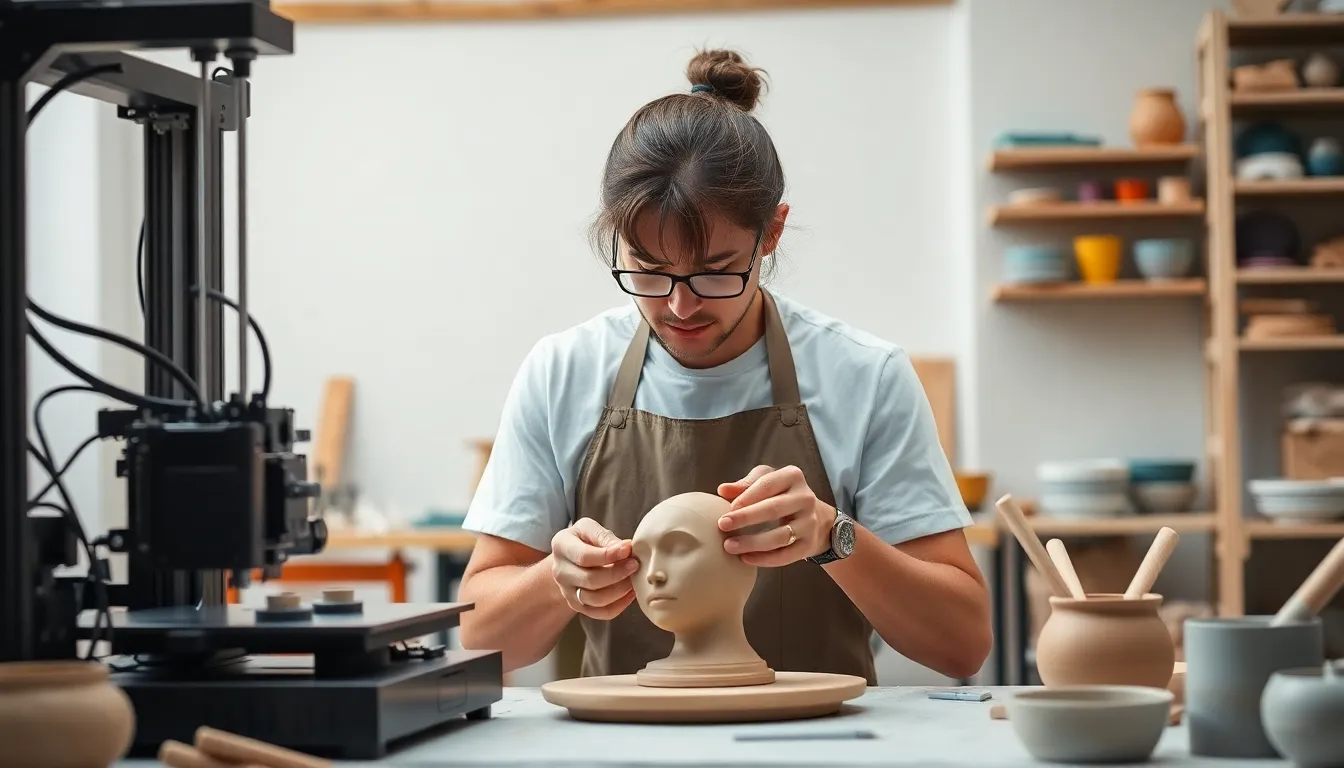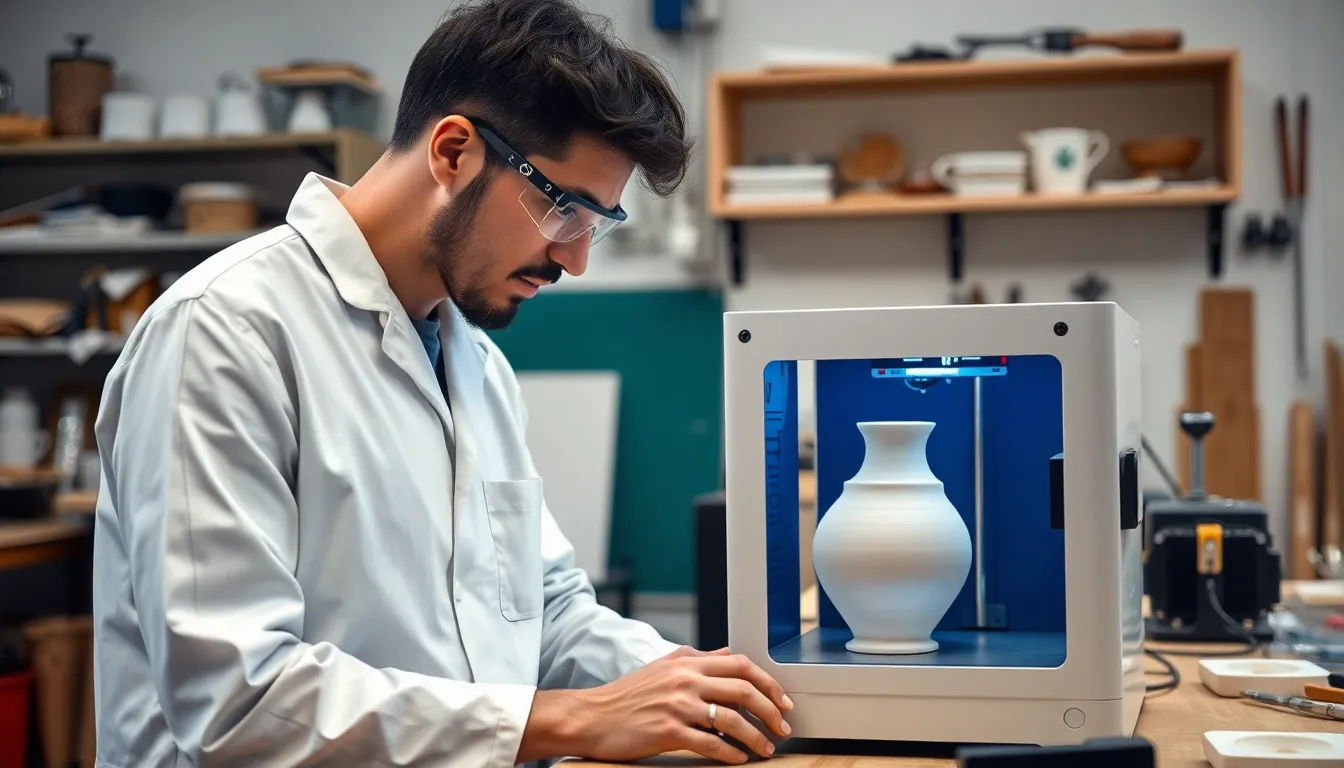Imagine a world where your wildest ceramic dreams come to life with just the push of a button. That’s the magic of 3D printing ceramics. Gone are the days of painstakingly molding clay and waiting for the kiln to work its wonders. Now, creativity meets technology in a delightful fusion that’s transforming everything from art to industry.
With 3D printing, anyone can whip up intricate designs that were once reserved for master potters. Whether it’s a quirky vase that’ll make your friends chuckle or a sleek tile that’ll impress the in-laws, the possibilities are endless. Plus, it’s eco-friendly! Who wouldn’t want to save the planet while crafting unique masterpieces? Buckle up as we dive into the fascinating world of 3D printed ceramics and uncover how this innovative technique is reshaping the art of pottery.
Table of Contents
ToggleOverview of 3D Printing Ceramics
3D printing ceramics involves using additive manufacturing techniques to produce ceramic objects layer by layer. This process enables the creation of complex shapes that traditional methods can’t achieve. Artists and manufacturers appreciate this technology for its precision and versatility, allowing for intricate designs that retain artistic expression.
The primary materials used in 3D printing ceramics include clay, porcelain, and stoneware. These materials undergo specific treatments to ensure proper flow during the printing process. Various 3D printing techniques, such as binder jetting and extrusion, provide different advantages. Binder jetting offers fast production speeds, while extrusion is ideal for more detailed work.
Applications of 3D printed ceramics span several industries. In architecture, it allows for unique structural elements. The ability to create customized tiles enhances both decorative and functional aspects. In the medical field, researchers explore 3D printed ceramics for prosthetics and dental applications as they offer biocompatibility and durability.
Sustainability plays a significant role in the appeal of 3D printing ceramics. This method reduces waste compared to traditional subtractive manufacturing. Furthermore, local production minimizes transportation costs and carbon footprints. Innovations continue to emerge, enhancing the eco-friendliness of the materials and processes.
Educational institutions are embracing this technology, incorporating 3D printing ceramics into curricula. Students gain hands-on experience with design software, printing equipment, and finishing techniques. As knowledge spreads, so does the potential for new ideas and creations, making 3D printing ceramics a forward-looking field.
Advantages of 3D Printing Ceramics

3D printing ceramics offers several key advantages that set it apart from traditional ceramic crafting methods.
Enhanced Design Flexibility
Enhanced design flexibility stands as a significant benefit of 3D printing ceramics. Artists can create intricate patterns and detailed structures that traditional techniques struggle to replicate. Unique geometries and complex forms emerge easily, allowing for innovation in artistic expression. Designers often explore various textures, shapes, and sizes without the constraints of manual molding. Advanced software enables precise adjustments to designs before printing, streamlining the process. Customization becomes more manageable, opening doors to personalized items tailored for specific needs. This technology empowers creators, encouraging experimentation and creativity in ways previously thought impractical.
Reduced Material Waste
Reduced material waste marks another crucial advantage of 3D printing ceramics. Traditional methods often involve substantial offcuts and excess clay, leading to environmental concerns. In contrast, 3D printing utilizes only the necessary amount of material for each project. Additive manufacturing techniques mean that objects form layer by layer, translating to less discarded waste. Efficient material use results in lower production costs, making it attractive for businesses and artists alike. Sustainable practices align with the growing demand for eco-friendly solutions in various industries. Consequently, reducing material waste enhances both economic and ecological outcomes for ceramic producers.
Applications of 3D Printing Ceramics
3D printing ceramics finds a variety of applications across several sectors, showcasing its versatility and innovation.
Art and Sculpture
Artists leverage 3D printing to explore complex forms and intricate designs unachievable with traditional methods. Unique sculptures and decorative pieces become possible with this technology, which allows for customized textures and patterns. Various materials, including porcelain, offer artists the ability to experiment and push creative boundaries. Moreover, exhibitions featuring 3D printed ceramic art continue to draw attention, highlighting the blend of craftsmanship and modern technology.
Medical Uses
In the medical field, 3D printed ceramics play a crucial role in developing prosthetics and dental implants. Their biocompatibility ensures safety and longevity for users. Dental applications utilize precision manufacturing to create tailored solutions for individual patients, enhancing comfort and aesthetic appeal. Additionally, research explores the use of ceramic materials in regenerative medicine, contributing to advancements in tissue engineering and patient-specific medical devices.
Industrial Components
Industries apply 3D printing ceramics for producing durable components that withstand harsh conditions. Manufacturing processes benefit from the ability to create complex parts with lightweight properties. Key sectors, such as aerospace and automotive, utilize these ceramics for prototypes and end-use components, reducing material waste. Enhanced design flexibility enables engineers to optimize performance and efficiency, making 3D printed ceramics an attractive alternative for traditional manufacturing techniques.
Challenges in 3D Printing Ceramics
3D printing ceramics presents several challenges that impact its widespread adoption and efficiency. Understanding these obstacles is essential for artists and manufacturers looking to leverage this technology.
Material Limitations
Material selection remains a significant challenge in 3D printing ceramics. Some available materials, such as clay and porcelain, may not provide the necessary strength or flexibility for specific applications. Certain ceramic additives can enhance properties but might also affect printability. Variability in material quality can lead to inconsistent results, creating complications during production. 3D printed ceramics often require additional glaze or finishing processes, which can complicate workflows. In many cases, manufacturers and artists seek materials that balance durability with aesthetic appeal. This search for suitable materials continues to drive innovation within the field.
Technical Expertise Required
Technical expertise plays a crucial role in successfully implementing 3D printing ceramics. Knowledge of different printing techniques is necessary to achieve desired results, as various methods provide distinct benefits and challenges. Understanding the intricacies of printer settings, such as temperature and speed, greatly influences print integrity. Professionals must also grasp post-processing steps that are often required to ensure the final product meets quality standards. Training in design software is another essential component, as design intricacies directly impact manufacturability. A skilled workforce capable of navigating these technical complexities is vital for maximizing the potential of 3D printing ceramics.
Future Trends in 3D Printing Ceramics
Emerging trends indicate a robust future for 3D printing ceramics, emphasizing innovation and sustainability. Research continues into advanced materials that enhance mechanical properties, expanding the potential applications of 3D printed ceramics in various industries. Innovations in bioceramics also attract attention, particularly for dental and orthopedic implants due to their compatibility with human tissue.
Sustainability remains a focal point, with advancements aimed at reducing production waste and carbon footprints. Eco-friendly materials, such as recycled ceramics, attract interest as manufacturers seek sustainable alternatives. Growth in localized production reduces transportation emissions, aligning with modern environmental standards.
Integration with other technologies enhances the capabilities of 3D printing ceramics. Combining artificial intelligence with design processes optimizes production by yielding efficient structures and minimizing resource consumption. This fusion fosters better design exploration, empowering artists and engineers to push boundaries further.
In the education sector, academic institutions increasingly adopt 3D printing ceramics into curricula. Students gain hands-on experience, preparing them for future careers in design and manufacturing. Workshops and community initiatives further expand access, encouraging a broader audience to explore creativity in ceramics.
Additionally, ongoing developments in multi-material printing techniques expand design possibilities. Artists can incorporate various textures, colors, and properties into single pieces, resulting in unique creations that reflect individual styles. The ability to combine materials opens new avenues for artistic expression and functional designs, ranging from intricate sculptures to repair components.
Collaboration among industry leaders and researchers also drives growth in this field. Partnerships promote knowledge-sharing, accelerating the development of new techniques and applications. These collective efforts create a vibrant ecosystem eager to innovate and push the boundaries of 3D printing ceramics.
The world of 3D printing ceramics is rapidly evolving offering unprecedented opportunities for creativity and innovation. This technology not only streamlines the production process but also enhances design possibilities that traditional methods can’t match. As industries continue to explore its potential the benefits of sustainability and reduced waste become increasingly significant.
With ongoing research into advanced materials and techniques the future looks promising. The integration of educational initiatives ensures that the next generation of artists and engineers will be well-equipped to harness the power of 3D printing ceramics. Embracing this technology paves the way for a new era in ceramic design and manufacturing.

